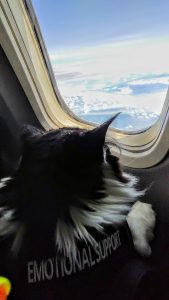Oklahoma Bar Journal
Traveling With Your Best Friend
By Morgan Maxey

diana | #678881081 | stock.adobe.com
Service, emotional support and assistance animals work diligently for millions of Americans every year. These invaluable companions may be floppy-eared friends when you need emotional support, the eyes upon which you rely as someone who knows your bark better than their own or your best mate for air travel adventures. In fact, traveling service animal companions have increased from 2,400 recognized in 2014 to over 200,000 recognized in 2019.[1]
Both federal and Oklahoma law provide designations for how a person may qualify for a furry or even scaly companion animal. Additionally, a large amount of law on this topic is spread between the U.S. Fair Housing Act, Americans with Disabilities Act and Air Carrier Access Act. The law is intricate and varies as it concerns qualifying for the use and assistance of a service, emotional support or assistance animal. This article will address the fun of flying with a qualified animal designated to assist with one’s disability and provide a general discussion of what effect various statutes and administrative rules have on these classifications of animals.
LAWS GOVERNING FLIGHT WITH YOUR COMPANION
The federal Air Carrier Access Act (ACAA) does not permit discrimination in any form concerning the necessity or existence of a person’s qualifying disability concerning traveling by flight.[2] The ACAA states that air carriers “may not discriminate against an otherwise qualified individual on the following grounds: the individual has a physical or mental impairment that substantially limits one or more major life activities, and the individual has a record of such an impairment.”[3] This act is enforced by the U.S. Department of Transportation.[4]
A “physical or mental impairment means any physiological disorder or condition, cosmetic disfigurement, or anatomical loss affecting one or more of the following body systems ... or any mental retardation, organic brain syndrome, emotional or mental illness, and specific learning disabilities.”[5] This definition “includes, but is not limited to, such disease and conditions as orthopedic, visual, speech, and hearing impairments, cerebral palsy, epilepsy, muscular dystrophy, multiple sclerosis, cancer, heart disease, diabetes, mental retardation, emotional illness, drug addiction, and alcoholism.”[6] The ACAA defines “major life activities” as “functions such as caring for oneself, performing manual tasks, walking, seeing, hearing, speaking, breathing, learning, and working.” Therefore, to qualify under the ACAA to fly with your companion animal, you must be diagnosed with one of the aforementioned disabilities.
The ACAA does permit service animals, but assistance animals are not addressed, and emotional support animals are specifically excluded.[7] If you are wondering about “therapy animals,” although they provide great value in their duties, they have no special legal designation and are not recognized by federal or Oklahoma law as it concerns assisting the disabled, unlike service, emotional support or assistance animals.
Note on Certification, Registration and Licensing of Animals
Neither federal nor Oklahoma law requires your companion helper to have any identifiers or signage as to their invaluable role in your life. Although there is no Oklahoma law specific to this issue, the Americans with Disabilities Act (ADA) prohibits inquiries of any sort of certification.[8] Moreover, one is not permitted to “ask about the person’s disability, require medical documentation, require a special identification card or training documentation for the dog, or ask that the dog demonstrate its ability to perform the work or task.”[9] For ease with flying though, it can be worth a simple purchase of items, such as a harness or leash, that designates your companions’ duties and/or classification as a service dog.
Is Your Co-Pilot an Official Co-Pup?
Unfortunately, no service animal in training qualifies for its flying wings until completing such training.[10] So make sure before attempting to fly with your service animal that those co-pup wings have been awarded.
What Inquiries May Be Made Regarding Your Travel Buddy?
Under federal law, only two questions may be asked concerning your service animal accompanying you. This applies in general when seeking public accommodation, not just when flying on an airplane. The questions are: 1) Do you require your service animal because of your disability? 2) What tasks has your service animal been trained to perform?[11] No request may be made to the service animal’s owner regarding proof of training or certification.[12] There is no Oklahoma law addressing this issue.
Definition of Accommodation
A reasonable accommodation, as defined in the ADA, is a modification or adjustment made to a system to accommodate or make the system equal for an individual based on a proven need.[13] That need can vary. If it is represented that the animal is a service dog, a public accommodation must be made, and only the two aforementioned questions may be asked.
Requirement for an Individual to Qualify as Having a Disability
Under federal and Oklahoma law, an animal owner only qualifies for a service, assistance or emotional support animal if they are either physically or mentally disabled.
Federal law defines “disability” within both the ADA and the U.S. Fair Housing Act (HOA).[14] The HOA uses the term “handicap” instead of disability, which applies to a person who has “a physical or mental impairment which substantially limits one or more of such person’s major life activities; a record of having such an impairment or being regarded as having such an impairment.”[15] Thus, the ADA and HOA have almost the same definitions.
Oklahoma law reflects the federal definitions defining “disability” as “any individual who is considered to have a disability or handicap for the purposes of any federal or Oklahoma law.”[16] The Oklahoma Fair Housing Act defines disability as “a mental or physical impairment that substantially limits at least one major life activity, when there is a record of such an impairment, or the individual is regarded as having such an impairment. The term does not include current illegal use of or addiction to any drug or illegal or federally controlled substance.”[17]
The ACAA’s Reasoning for Recognizing the Use of Service Animals

Morgan Maxey's dog, Zoey
The U.S. Department of Transportation (DOT) has provided multiple reasons for its current recognition of service animals in flight, which were in response to the concerns of individuals with disabilities, airline corporations, airline staff, airports and other parties involved in daily flights. DOT’s reasoning includes “(1) the increasing number of service animal complaints received ...; (2) the inconsistent definition among Federal agencies of what constitutes a ‘service animal’; (3) the disruptions caused by requests to transport unusual species of animals onboard aircraft ...; (4) the increasing frequency of incidents of travelers fraudulently representing their pets as service animals; and (5) the reported increase in the incidents of misbehavior by emotional support animals.”[18] Deservedly, the necessity of such a flight companion, and its participation above the clouds, has been recognized as an important issue by a diverse range of petting parties involved in air travel.
SERVICE ANIMALS, ASSISTANCE ANIMALS, EMOTIONAL SUPPORT ANIMALS BUT NOT THERAPY ANIMALS, ‘OH MY’: ANIMALS THAT QUALIFY
Service Animals
The ADA provides multiple definitions of service animals within Title III under Public Accommodations: “any dog that is individually trained to do work or perform tasks for the benefit of an individual with a disability.”[19] As it applies to non-air travel, “any guide dog, signal dog, or other animal individually trained to work or perform tasks for an individual with a disability, including ... work or perform tasks for an individual with impaired vision, alerting individuals with impaired hearing to intruders, or sounds, providing minimal protection or rescue work, preventing a child with autism from wandering away.”[20] It goes on to further include “pulling a wheelchair or fetching dropped items.”[21] It concludes, a dog “that is individually trained to do work or perform tasks for the benefit of an individual with a disability, including a physical, sensory, psychiatric, intellectual or other mental disability.”[22] Title III includes the service of only one other species than a dog as being a qualifying service animal, a miniature horse. Title I “employment” of the ADA does not provide a definition of a service animal but does mandate employers to make “reasonable accommodations” for people with disabilities.[23]
Oklahoma has no specific law concerning service animals. Thus, one should look to the ADA to fill this role. Oklahoma does have a law that punishes individuals who attempt to unlawfully claim their pet as a service animal regarding the rental of a home.[24]
Assistance Animals
The U.S. Fair Housing Act sets forth the federal classification of an “assistance animal.” It may be either 1) an individually trained dog or 2) a “support animal,”[25] which could be a “common household animal” (i.e., dog, cat or rabbit) or a “unique animal” (i.e., otter, pig or monkey).[26]
Under Oklahoma’s Title 41, an “assistance animal” is “an animal that works, provides assistance or performs tasks for the benefit of a person with a disability, or provides emotional support that alleviates one or more identified symptoms or effects of a person's disability.”[27] It includes “animals specifically trained or equipped to perform tasks for a person with a disability, or an emotional support animal that provides support to a person with a disability who has a disability-related need for such support.”[28]
Emotional Support Animals
Emotional support animals serve people by providing comfort and emotional well-being. These animals are not trained to assist with a person’s disability in any specified manner.
As it concerns federal law, the ADA excludes “emotional support animals.”[29] However, the U.S. Fair Housing Act does provide for assistance animals that offer “emotional support that alleviates one or more identified symptoms or effects of a person’s disability”[30] with no “requirement that the animal be trained.”[31]
CONCLUSION
A service animal is defined under federal and some Oklahoma law and rules. This classification of friendly companion applies to a service animal’s assistance well beyond airline flying. The ADA’s regulations focus on individual training and clear implications that the language of “perform work or do tasks” generally requires a service animal to perform physical tasks.[32] The law presently is that emotional support animals do not need to be accommodated.
The current ADA regulations continue to leave the proprietors of public accommodations with little guidance on how to deal with situations where an individual without an apparent disability purports to be accompanied by a service animal. Each airline, both American and foreign, has developed requirements to make certain that service animals comply with the necessary rules to fly. Given that there are individuals with apparent disabilities using service animals who are refused service, it is clear that continuing education is necessary to ensure that all individuals with disabilities, apparent or not, benefit from the protections of the law whether flying, dining in a restaurant, attending a public event or any other public activities.
 ABOUT THE AUTHOR
ABOUT THE AUTHOR
Morgan Maxey is an associate attorney with the Wirth Law Office in Tulsa and of counsel with the Maxey Law Firm in Enid. His practice focuses primarily on criminal defense law, animal law, deprived and juvenile criminal law and family law. He is licensed to practice in both the Cherokee Nation Tribal Court and the Muscogee (Creek) Nation District Court, as well as in Oklahoma. Mr. Maxey serves as an OBA YLD board member and is the OBA Animal Law Section YLD liaison.
ENDNOTES
[1] Emma. “Most Remarkable Service Dog Statistics in 2022,” Pawsome Advice (Jan. 9, 2022), https://bit.ly/4bCJ8Iu (a website promoting the use of emotional support animals) (last visited Feb. 12, 2024).
[2] 49 USC §41705(a).
[3] Id.
[4] 49 U.S.C. §41705; and 14 C.F.R. Part 382 et seq.
[5] Id
[6] Id.
[7] Id.
[8] 28 C.F.R. §§35.193, 36.104.
[9] “ADA Requirements: Service Animals,” ADA (Feb. 24, 2020), https://bit.ly/49b3vv2 (last visited Feb. 12, 2024).
[10] 14 CFR §382.3.
[11] 28 C.F.R. §36.302(c)(6).
[12] Id.
[13] 29 C.F.R. §1630.9.
[14] 42 U.S.C. §12102.
[15] 42 U.S.C. §3601 et seq.
[16] 62 O.S. §34.29(2).
[17] 42 U.S.C. §3601 et seq.
[18] Traveling by Air with Service Animals Advance Notice of Proposed Rulemaking. 83 Fed. Reg. 23832 (May 23, 2018).
[19] 28 C.F.R. §35.104.
[20] Id.
[21] Id.
[22] Id.
[23] Id.
[24] 49 O.S. §113.2.C-D; See also Michael Ollove “Several states crack down ‘fake’ service animals,” USA TODAY Oct. 29, 2017, https://bit.ly/3UHxrdF (last visited Feb. 12, 2024).
[25] See https://bit.ly/3T8ee3R (last visited Feb. 21, 2024).
[26] Id.
[27] 41 O.S §113.2.
[28] Id.
[29] 28 C.F.R. §36.104.
[30] See https://bit.ly/3T8ee3R (last visited Feb. 21, 2024).
[31] Id.
[32] 42 U.S.C §12102.
Originally published in the Oklahoma Bar Journal – OBJ 95 No. 3 (March 2024)
Statements or opinions expressed in the Oklahoma Bar Journal are those of the authors and do not necessarily reflect those of the Oklahoma Bar Association, its officers, Board of Governors, Board of Editors or staff.
